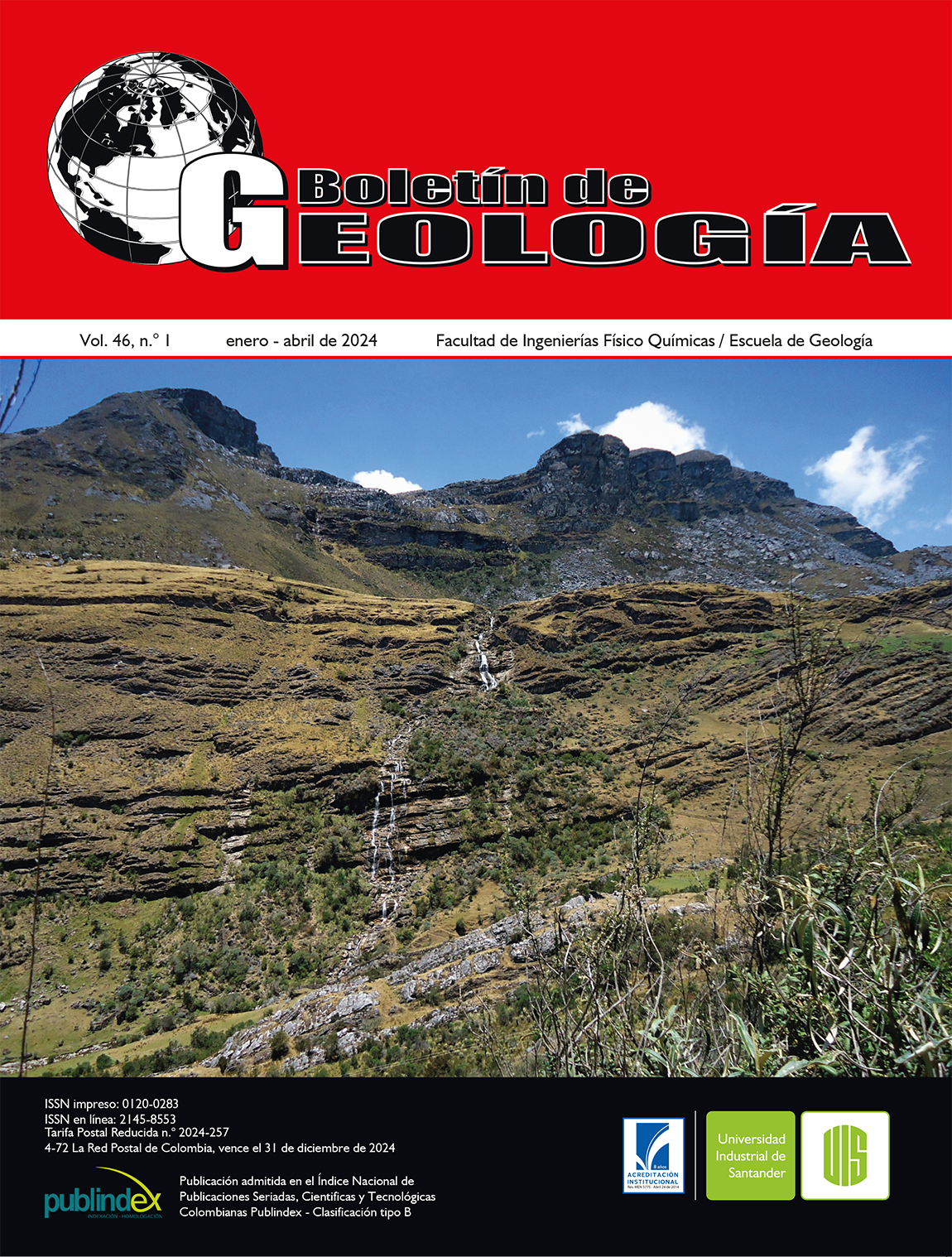Thin section identification of Clavihedbergella simplex and Clavihedbergella moremani species present in Cretaceous rocks from the central part of Middle Magdalena Valley, Colombia
Published 2024-03-08
Keywords
- Calcareous fossils,
- Foraminifera,
- Genus Clavihedbergella,
- Taxonomic description,
- Cenomanian
- Turonian ...More
How to Cite
Copyright (c) 2024 Boletín de Geología

This work is licensed under a Creative Commons Attribution 4.0 International License.
Altmetrics
Abstract
The planktonic foraminifera study using thin sections is relatively recent and in the case of Clavihedbergella simplex and Clavihedbergella moremani species is a method that enhances their observation and identification, even more in cretaceous colombian rocks where traditional peroxide preparation method is not effective. This study provides a taxonomic description of these species using thin section fossils and identifies their occurrence along the cretaceous rocks in a well located in the central part of the Middle Magdalena Valley, Colombia. The guidelines presented in this study validates the usefulness of this investigation method and ease the identification of these two species in thin section.
Downloads
References
- Arz, J.A.; Molina E. (2002). Bioestratigrafía y cronoestratigrafía con foraminíferos planctónicos del Campaniense superior y Maastrichtiense de latitudes templadas y subtropicales (España, Francia y Tunicia). Neues Jahrbuch für Geologie und Paläontologie, Abhandlungen, 224(2), 161-195. http://doi.org/10.1127/nigpa/224/2002/161
- Banner, F.T.; Blow, W.H. (1959). The classification and stratigraphical distribution of the Globigerinaceae. Palaeontology, 2(1), 1-27.
- Bolli, H. (1945). Zur Stratigraphie der Oberen Kreide in den höheren helvetischen Decken. Eclogae Geologic Helvetiae, 37, 217-331. http://doi.org/10.5169/seals160503
- Bolli, H.; Saunders, J.; Perch-Nielsen, K. (1989). Plankton Stratigraphy. Cambridge University Press.
- Caron, M. (1978). Cretaceous Planktonic Foraminifers from DSDP Leg 40, Southeastern Atlantic Ocean. Initial Reports of the Deep Sea Drilling Project, 40. https://doi.org/10.2973/dsdp.proc.40.114.1978
- Coccioni, H.; Premoli-Silva, I. (2015). Revised Upper Albian-Maastrichtian planktonic foraminiferal biostratigraphy and magneto-stratigraphy of the classical Tethyan Gubbio section (Italy). Newsletters on Stratigraphy, 48(1), 47-90. https://doi.org/10.1127/nos/2015/0055
- Cushman, J.A. (1931). Hastigerinella and other interesting foraminifera from the Upper Cretaceous of Texas. Contributions from the Cushman Laboratory for Foraminiferal Research, 7(4), 83-90.
- Eicher, D.L.; Worstell, P. (1970). Lunatriella, a Cretaceous Heterohelicid Foraminifer from the Western Interior of the United States. Micropaleontology, 16(1), 117-121. https://doi.org/10.2307/1484852
- Jaff, R.B.N. (2021). A designed model for identifications of Dicarinella concavata (Brotzen, 1934) and Dicarinella asymetrica (Sigal, 1952) planktic foraminifer species under thin sections: an example from the Kurdistan region, NE Iraq. Jordan Journal of Earth and Environmental Sciences, 12(2), 154-162.
- Jones, R.W. (2014). Foraminifera and their Applications. Cambridge University Press. https://doi.org/10.1017/CBO9781139567619
- Kalanat, B.; Vaziri-Moghaddam, H.; Bijani, S. (2021). Depositional history of the uppermost Albian–Turonian Sarvak Formation in the Izeh Zone (SW Iran). International Journal of Earth Sciences, 110(1), 305-330. https://doi.org/10.1007/s00531-020-01954-1
- Khan, S.; Kroon, D.; Ahmad, S.; Ali, A.; Wadood, B.; Rahman, A. (2021). Planktonic foraminiferal biostratigraphy of the Cretaceous strata, Indus Basin, Pakistan, Eastern Tethys: implications for oceanic anoxic events. Australian Journal of Earth Sciences, 68(8), 1162-1178. https://doi.org/10.1080/08120099.2021.1913225
- Kopaevich, L.F.; Gorbachik T.N. (2017). Shell morphology of cretaceous planktonic foraminifers as a mean for paleoenvironment reconstructions. Paleontological Journal, 51(1), 1-12. https://doi.org/10.1134/S0031030117010075
- Leckie, R.M. (1984). Mid-Cretaceous planktonic foraminiferal biostratigraphy off central Morocco, Deep Sea Drilling Project Leg 79, Sites 545 and 547. Initial Reports Deep Sea Drilling Project, 79, 579-620. https://doi.org/10.2973/dsdp.proc.79.122.1984
- Loeblich, A.R.; Tappan, H. (1961). Cretaceous planktonic foraminifera: Part I Cenomanian. Micropaleontology, 7(3), 257-304. https://doi.org/10.2307/1484364
- Miles, G.A.; Orr, W.N. (1980). Planktonic foraminifers from the Bermuda Rise, deep sea drilling project Legs 51, 52, and 53. Initial Reports of the Deep Sea Drilling Project, 51, 52-53. https://doi.org/10.2973/dsdp.proc.515253.114.1980
- Monteiro, F.M.; Pancost, R.D; Ridgwell, A.; Donadieu, Y. (2012). Nutrients as the dominant control on the spread of anoxia and euxinia across the Cenomanian-Turonian oceanic anoxic event (OAE2): Model-data comparison. Paleoceanography and Paleoclimatology, 27(4), PA4209. http://doi.org/10.1029/2012PA002351
- Morrow, A.L. (1934). Foraminifera and ostracoda from the Upper Cretaceous of Kansas. Journal of Paleontology, 8(2), 186-205.
- Odin G.S.; Lamaurelle M.A. (2001). The global Campanian-Maastrichtian stage boundary. Episodes Journal of International Geoscience, 24(4), 229-238. https://doi.org/10.18814/epiiugs/2001/v24i4/002
- Pessagno, E.A. (1967). Upper Cretaceous planktonic foraminifera from the western Gulf Coastal Plain. Palaeontographica Americana, 5(37), 245-445.
- Premoli-Silva, I.; Bolli, H.M. (1973). Late Cretaceous to Eocene planktonic foraminifera and stratigraphy of Leg 15 sites in the Caribbean Sea. Initial reports of Deep Sea Drilling Project, 15, 449-547. https://doi.org/10.2973/dsdp.proc.15.111.1973
- Premoli-Silva, I.; Verga, D. (2004). Practical manual of Cretaceous planktonic foraminifera. International School on Planktonic foraminifera, 3º Course: Cretaceous.
- Premoli-Silva, I.; Verga, D. (2011). Practical manual of Cretaceous planktonic foraminifera. International School on Planktonic foraminifera, 3º Course: Cretaceous.
- Renz, O. (1936). Stratigraphische und mikropalaeontologische untersuchung der Scaglia (Obere Kreide-Tertiär) im zentralen Apennin. Eclogae Geologicae Helvetiae, 29(1), 1-149. https://doi.org/10.5169/seals-159606
- Robaszynski, F.; Caron, M.; Gonzalez-Donoso, J.M.; Wonders, A.A.H. (1984). Atlas of Late Cretaceous globotruncanids. Revue de Micropaléontologie, 26(3-4), 145-305.
- Sliter, W.V. (1989). Biostratigraphic zonation for Cretaceous planktonic foraminifers examined in thin section. Journal of Foraminiferal Research, 19(1), 1-19. https://doi.org/10.2113/gsjfr.19.1.1
- Sliter, W.V. (1999). Cretaceous planktic foraminiferal biostratigraphy of the Calera Limestone, northern California, USA. Journal of Foraminiferal Research, 29(4), 318-339.
- Sýkora, M.; Ozvoldova, L.; Boorová, D. (1997). Turonian silicified sediments in the Czorsztyn Succession of the Pieniny Klippen belt (western Carpathians, Slovakia). Geologica Carpathica- Bratislava, 48(4), 243-261.
- Villamil, T.; Arango, C.; Hay W.W. (1999). Plate tectonic paleoceanographic hypothesis for Cretaceous source rocks and cherts of northern South America. AAPG Bulletin, 5. https://doi.org/10.1130/0-8137-2332-9.191
- Young, J.R.; Wade, B.S.; Huber B.T. (2017) pforams@ mikrotax website. http://www.mikrotax.org/pforams

